Business and Business Environment: A Report on Sainsbury's Analysis
VerifiedAdded on 2023/01/12
|15
|3881
|62
Report
AI Summary
This report offers a comprehensive analysis of Sainsbury's business environment, evaluating various aspects of its operations. It begins with an introduction to the business environment and a brief overview of Sainsbury's. The main body of the report covers key topics, including the types and purposes of organizations, the size and scope of different organizational structures, and the relationships between various organizational functions such as HR, marketing, and finance. The report also features a detailed PESTEL analysis, examining the political, economic, social, technological, environmental, and legal factors influencing Sainsbury's. Furthermore, it includes a SWOT/TOWS analysis, exploring the company's strengths, weaknesses, opportunities, and threats, and the interrelation of strengths and weaknesses with macro factors. The report concludes with a summary of the findings and references used.

BUSINESS AND BUSINESS
ENVIRONMENT
ENVIRONMENT
Paraphrase This Document
Need a fresh take? Get an instant paraphrase of this document with our AI Paraphraser
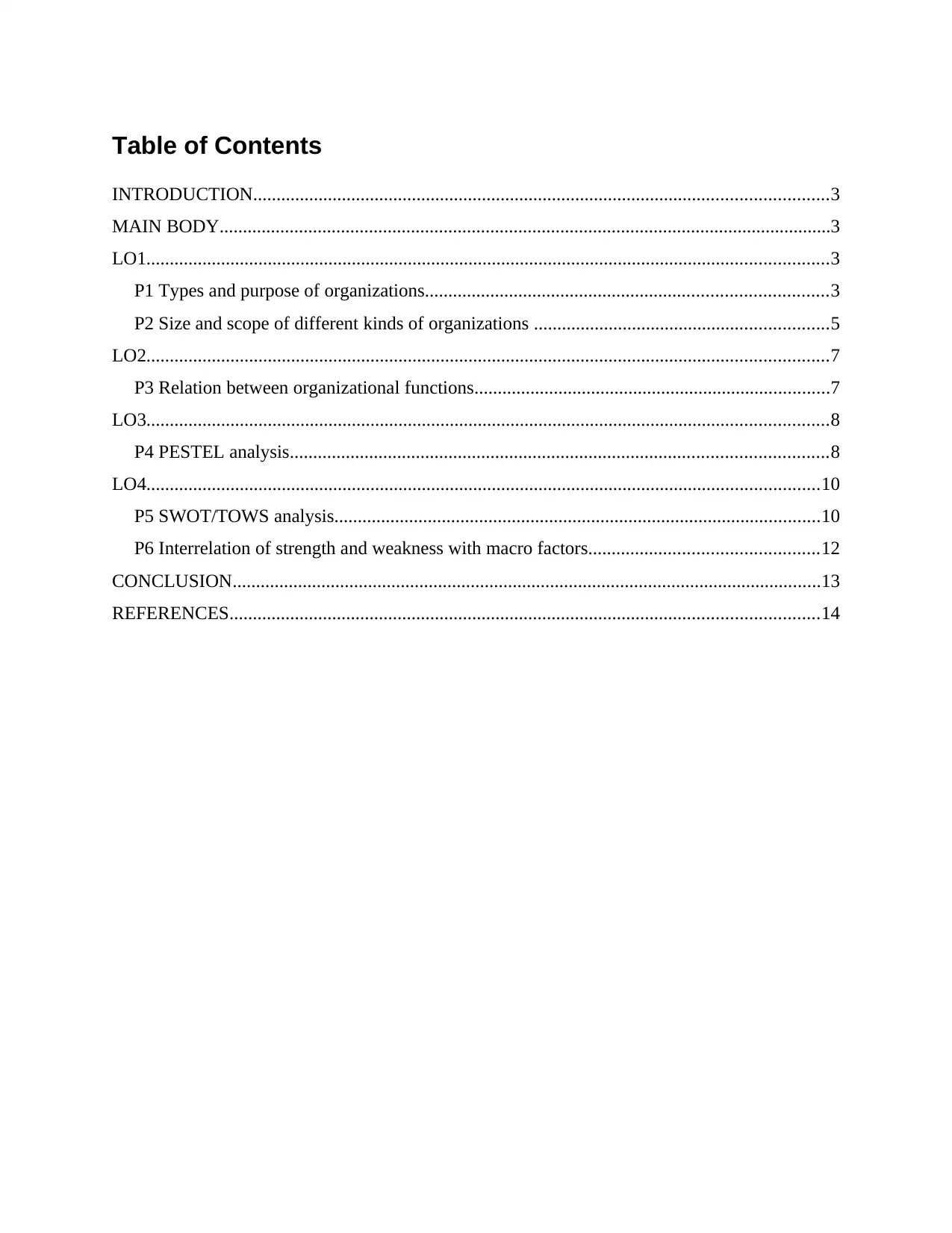
Table of Contents
INTRODUCTION...........................................................................................................................3
MAIN BODY...................................................................................................................................3
LO1..................................................................................................................................................3
P1 Types and purpose of organizations......................................................................................3
P2 Size and scope of different kinds of organizations ...............................................................5
LO2..................................................................................................................................................7
P3 Relation between organizational functions............................................................................7
LO3..................................................................................................................................................8
P4 PESTEL analysis...................................................................................................................8
LO4................................................................................................................................................10
P5 SWOT/TOWS analysis........................................................................................................10
P6 Interrelation of strength and weakness with macro factors.................................................12
CONCLUSION..............................................................................................................................13
REFERENCES..............................................................................................................................14
INTRODUCTION...........................................................................................................................3
MAIN BODY...................................................................................................................................3
LO1..................................................................................................................................................3
P1 Types and purpose of organizations......................................................................................3
P2 Size and scope of different kinds of organizations ...............................................................5
LO2..................................................................................................................................................7
P3 Relation between organizational functions............................................................................7
LO3..................................................................................................................................................8
P4 PESTEL analysis...................................................................................................................8
LO4................................................................................................................................................10
P5 SWOT/TOWS analysis........................................................................................................10
P6 Interrelation of strength and weakness with macro factors.................................................12
CONCLUSION..............................................................................................................................13
REFERENCES..............................................................................................................................14
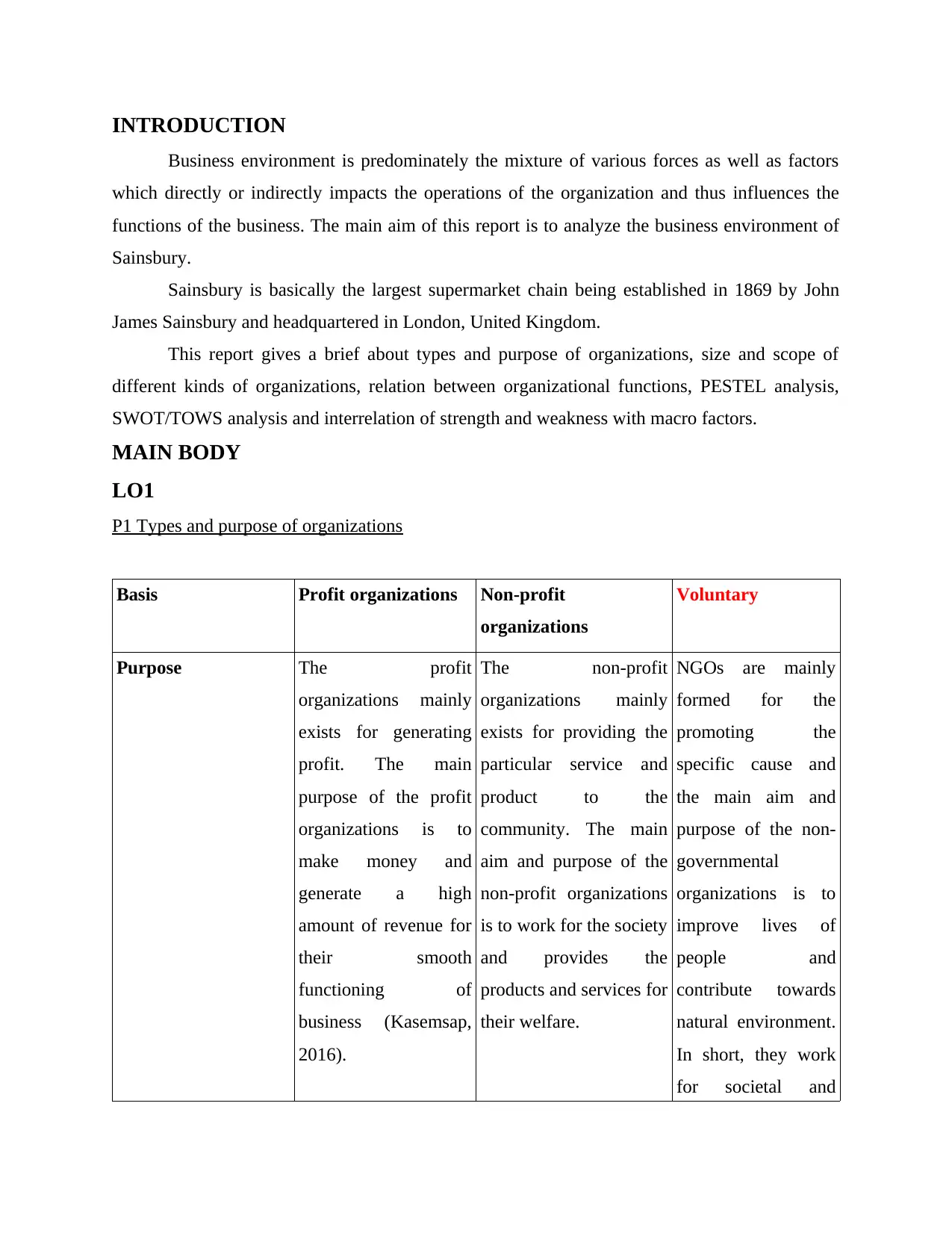
INTRODUCTION
Business environment is predominately the mixture of various forces as well as factors
which directly or indirectly impacts the operations of the organization and thus influences the
functions of the business. The main aim of this report is to analyze the business environment of
Sainsbury.
Sainsbury is basically the largest supermarket chain being established in 1869 by John
James Sainsbury and headquartered in London, United Kingdom.
This report gives a brief about types and purpose of organizations, size and scope of
different kinds of organizations, relation between organizational functions, PESTEL analysis,
SWOT/TOWS analysis and interrelation of strength and weakness with macro factors.
MAIN BODY
LO1
P1 Types and purpose of organizations
Basis Profit organizations Non-profit
organizations
Voluntary
Purpose The profit
organizations mainly
exists for generating
profit. The main
purpose of the profit
organizations is to
make money and
generate a high
amount of revenue for
their smooth
functioning of
business (Kasemsap,
2016).
The non-profit
organizations mainly
exists for providing the
particular service and
product to the
community. The main
aim and purpose of the
non-profit organizations
is to work for the society
and provides the
products and services for
their welfare.
NGOs are mainly
formed for the
promoting the
specific cause and
the main aim and
purpose of the non-
governmental
organizations is to
improve lives of
people and
contribute towards
natural environment.
In short, they work
for societal and
Business environment is predominately the mixture of various forces as well as factors
which directly or indirectly impacts the operations of the organization and thus influences the
functions of the business. The main aim of this report is to analyze the business environment of
Sainsbury.
Sainsbury is basically the largest supermarket chain being established in 1869 by John
James Sainsbury and headquartered in London, United Kingdom.
This report gives a brief about types and purpose of organizations, size and scope of
different kinds of organizations, relation between organizational functions, PESTEL analysis,
SWOT/TOWS analysis and interrelation of strength and weakness with macro factors.
MAIN BODY
LO1
P1 Types and purpose of organizations
Basis Profit organizations Non-profit
organizations
Voluntary
Purpose The profit
organizations mainly
exists for generating
profit. The main
purpose of the profit
organizations is to
make money and
generate a high
amount of revenue for
their smooth
functioning of
business (Kasemsap,
2016).
The non-profit
organizations mainly
exists for providing the
particular service and
product to the
community. The main
aim and purpose of the
non-profit organizations
is to work for the society
and provides the
products and services for
their welfare.
NGOs are mainly
formed for the
promoting the
specific cause and
the main aim and
purpose of the non-
governmental
organizations is to
improve lives of
people and
contribute towards
natural environment.
In short, they work
for societal and
⊘ This is a preview!⊘
Do you want full access?
Subscribe today to unlock all pages.

Trusted by 1+ million students worldwide
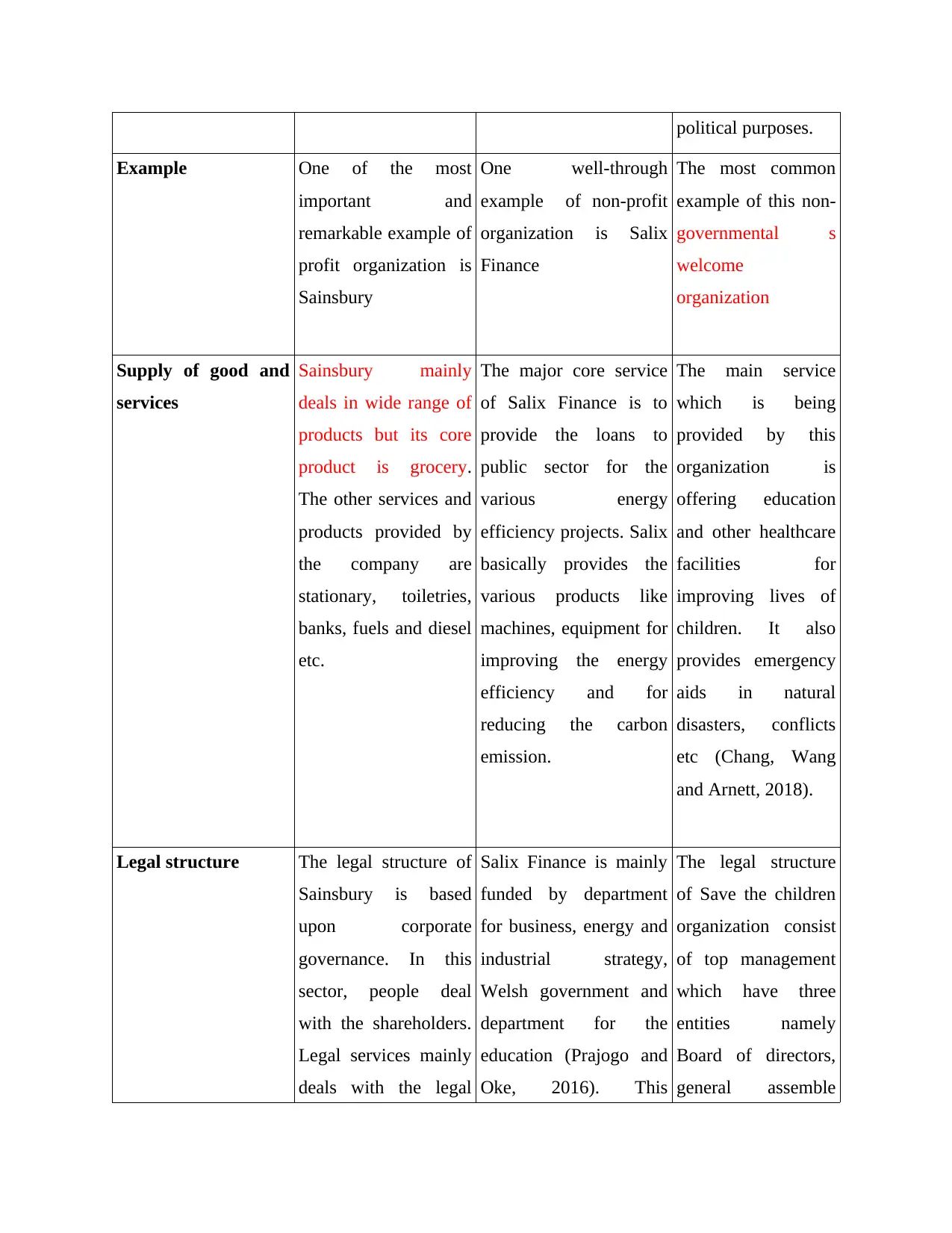
political purposes.
Example One of the most
important and
remarkable example of
profit organization is
Sainsbury
One well-through
example of non-profit
organization is Salix
Finance
The most common
example of this non-
governmental s
welcome
organization
Supply of good and
services
Sainsbury mainly
deals in wide range of
products but its core
product is grocery.
The other services and
products provided by
the company are
stationary, toiletries,
banks, fuels and diesel
etc.
The major core service
of Salix Finance is to
provide the loans to
public sector for the
various energy
efficiency projects. Salix
basically provides the
various products like
machines, equipment for
improving the energy
efficiency and for
reducing the carbon
emission.
The main service
which is being
provided by this
organization is
offering education
and other healthcare
facilities for
improving lives of
children. It also
provides emergency
aids in natural
disasters, conflicts
etc (Chang, Wang
and Arnett, 2018).
Legal structure The legal structure of
Sainsbury is based
upon corporate
governance. In this
sector, people deal
with the shareholders.
Legal services mainly
deals with the legal
Salix Finance is mainly
funded by department
for business, energy and
industrial strategy,
Welsh government and
department for the
education (Prajogo and
Oke, 2016). This
The legal structure
of Save the children
organization consist
of top management
which have three
entities namely
Board of directors,
general assemble
Example One of the most
important and
remarkable example of
profit organization is
Sainsbury
One well-through
example of non-profit
organization is Salix
Finance
The most common
example of this non-
governmental s
welcome
organization
Supply of good and
services
Sainsbury mainly
deals in wide range of
products but its core
product is grocery.
The other services and
products provided by
the company are
stationary, toiletries,
banks, fuels and diesel
etc.
The major core service
of Salix Finance is to
provide the loans to
public sector for the
various energy
efficiency projects. Salix
basically provides the
various products like
machines, equipment for
improving the energy
efficiency and for
reducing the carbon
emission.
The main service
which is being
provided by this
organization is
offering education
and other healthcare
facilities for
improving lives of
children. It also
provides emergency
aids in natural
disasters, conflicts
etc (Chang, Wang
and Arnett, 2018).
Legal structure The legal structure of
Sainsbury is based
upon corporate
governance. In this
sector, people deal
with the shareholders.
Legal services mainly
deals with the legal
Salix Finance is mainly
funded by department
for business, energy and
industrial strategy,
Welsh government and
department for the
education (Prajogo and
Oke, 2016). This
The legal structure
of Save the children
organization consist
of top management
which have three
entities namely
Board of directors,
general assemble
Paraphrase This Document
Need a fresh take? Get an instant paraphrase of this document with our AI Paraphraser
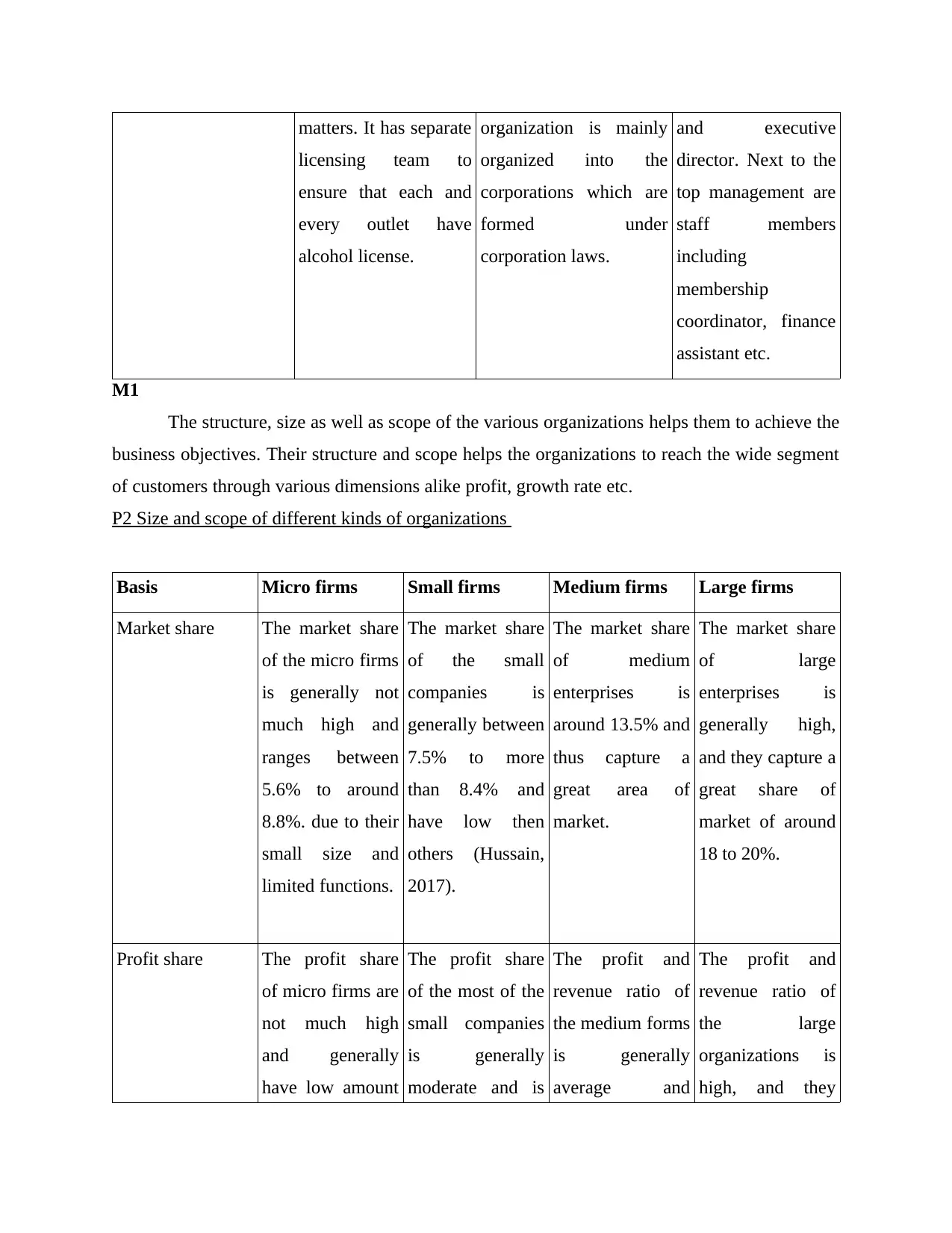
matters. It has separate
licensing team to
ensure that each and
every outlet have
alcohol license.
organization is mainly
organized into the
corporations which are
formed under
corporation laws.
and executive
director. Next to the
top management are
staff members
including
membership
coordinator, finance
assistant etc.
M1
The structure, size as well as scope of the various organizations helps them to achieve the
business objectives. Their structure and scope helps the organizations to reach the wide segment
of customers through various dimensions alike profit, growth rate etc.
P2 Size and scope of different kinds of organizations
Basis Micro firms Small firms Medium firms Large firms
Market share The market share
of the micro firms
is generally not
much high and
ranges between
5.6% to around
8.8%. due to their
small size and
limited functions.
The market share
of the small
companies is
generally between
7.5% to more
than 8.4% and
have low then
others (Hussain,
2017).
The market share
of medium
enterprises is
around 13.5% and
thus capture a
great area of
market.
The market share
of large
enterprises is
generally high,
and they capture a
great share of
market of around
18 to 20%.
Profit share The profit share
of micro firms are
not much high
and generally
have low amount
The profit share
of the most of the
small companies
is generally
moderate and is
The profit and
revenue ratio of
the medium forms
is generally
average and
The profit and
revenue ratio of
the large
organizations is
high, and they
licensing team to
ensure that each and
every outlet have
alcohol license.
organization is mainly
organized into the
corporations which are
formed under
corporation laws.
and executive
director. Next to the
top management are
staff members
including
membership
coordinator, finance
assistant etc.
M1
The structure, size as well as scope of the various organizations helps them to achieve the
business objectives. Their structure and scope helps the organizations to reach the wide segment
of customers through various dimensions alike profit, growth rate etc.
P2 Size and scope of different kinds of organizations
Basis Micro firms Small firms Medium firms Large firms
Market share The market share
of the micro firms
is generally not
much high and
ranges between
5.6% to around
8.8%. due to their
small size and
limited functions.
The market share
of the small
companies is
generally between
7.5% to more
than 8.4% and
have low then
others (Hussain,
2017).
The market share
of medium
enterprises is
around 13.5% and
thus capture a
great area of
market.
The market share
of large
enterprises is
generally high,
and they capture a
great share of
market of around
18 to 20%.
Profit share The profit share
of micro firms are
not much high
and generally
have low amount
The profit share
of the most of the
small companies
is generally
moderate and is
The profit and
revenue ratio of
the medium forms
is generally
average and
The profit and
revenue ratio of
the large
organizations is
high, and they
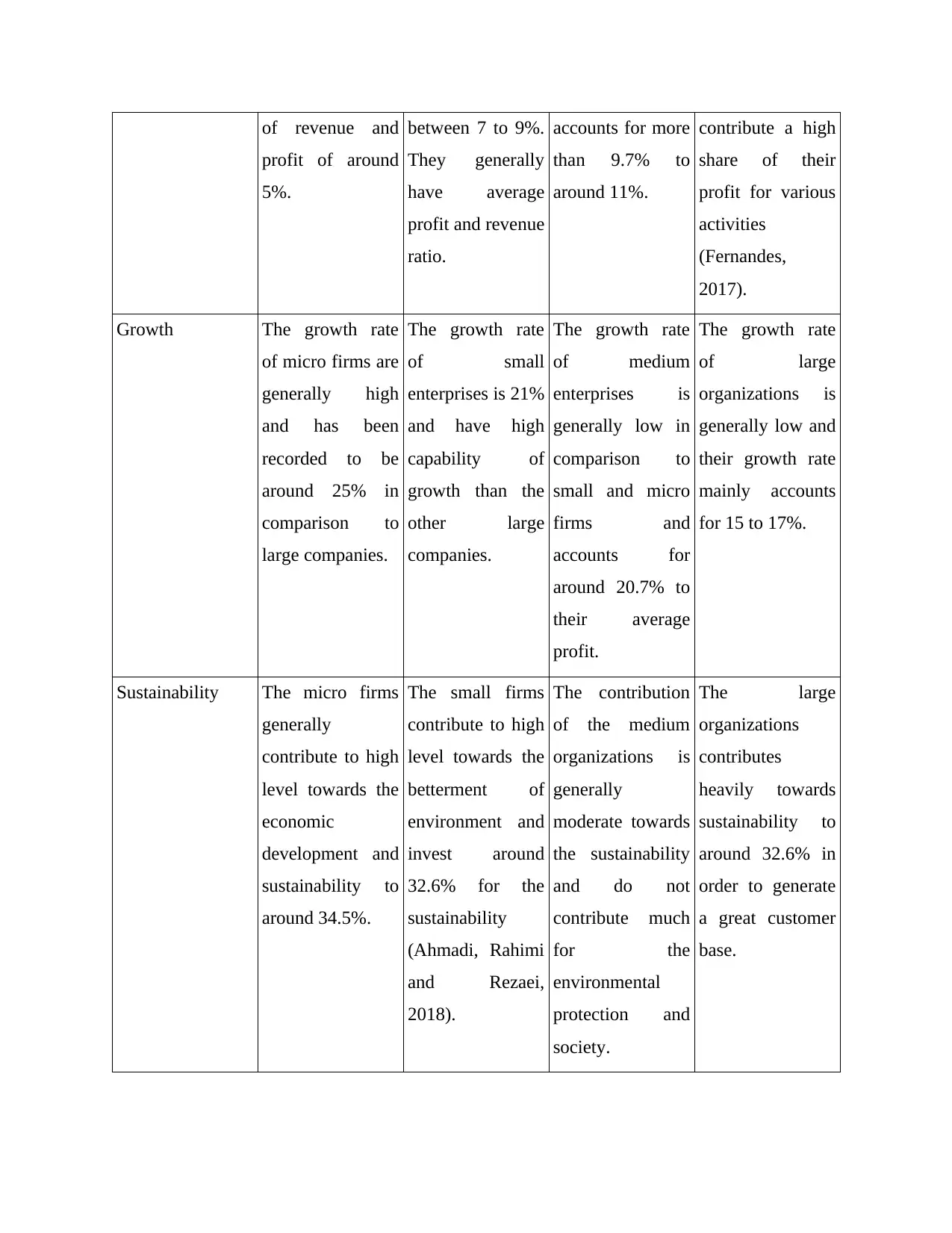
of revenue and
profit of around
5%.
between 7 to 9%.
They generally
have average
profit and revenue
ratio.
accounts for more
than 9.7% to
around 11%.
contribute a high
share of their
profit for various
activities
(Fernandes,
2017).
Growth The growth rate
of micro firms are
generally high
and has been
recorded to be
around 25% in
comparison to
large companies.
The growth rate
of small
enterprises is 21%
and have high
capability of
growth than the
other large
companies.
The growth rate
of medium
enterprises is
generally low in
comparison to
small and micro
firms and
accounts for
around 20.7% to
their average
profit.
The growth rate
of large
organizations is
generally low and
their growth rate
mainly accounts
for 15 to 17%.
Sustainability The micro firms
generally
contribute to high
level towards the
economic
development and
sustainability to
around 34.5%.
The small firms
contribute to high
level towards the
betterment of
environment and
invest around
32.6% for the
sustainability
(Ahmadi, Rahimi
and Rezaei,
2018).
The contribution
of the medium
organizations is
generally
moderate towards
the sustainability
and do not
contribute much
for the
environmental
protection and
society.
The large
organizations
contributes
heavily towards
sustainability to
around 32.6% in
order to generate
a great customer
base.
profit of around
5%.
between 7 to 9%.
They generally
have average
profit and revenue
ratio.
accounts for more
than 9.7% to
around 11%.
contribute a high
share of their
profit for various
activities
(Fernandes,
2017).
Growth The growth rate
of micro firms are
generally high
and has been
recorded to be
around 25% in
comparison to
large companies.
The growth rate
of small
enterprises is 21%
and have high
capability of
growth than the
other large
companies.
The growth rate
of medium
enterprises is
generally low in
comparison to
small and micro
firms and
accounts for
around 20.7% to
their average
profit.
The growth rate
of large
organizations is
generally low and
their growth rate
mainly accounts
for 15 to 17%.
Sustainability The micro firms
generally
contribute to high
level towards the
economic
development and
sustainability to
around 34.5%.
The small firms
contribute to high
level towards the
betterment of
environment and
invest around
32.6% for the
sustainability
(Ahmadi, Rahimi
and Rezaei,
2018).
The contribution
of the medium
organizations is
generally
moderate towards
the sustainability
and do not
contribute much
for the
environmental
protection and
society.
The large
organizations
contributes
heavily towards
sustainability to
around 32.6% in
order to generate
a great customer
base.
⊘ This is a preview!⊘
Do you want full access?
Subscribe today to unlock all pages.

Trusted by 1+ million students worldwide
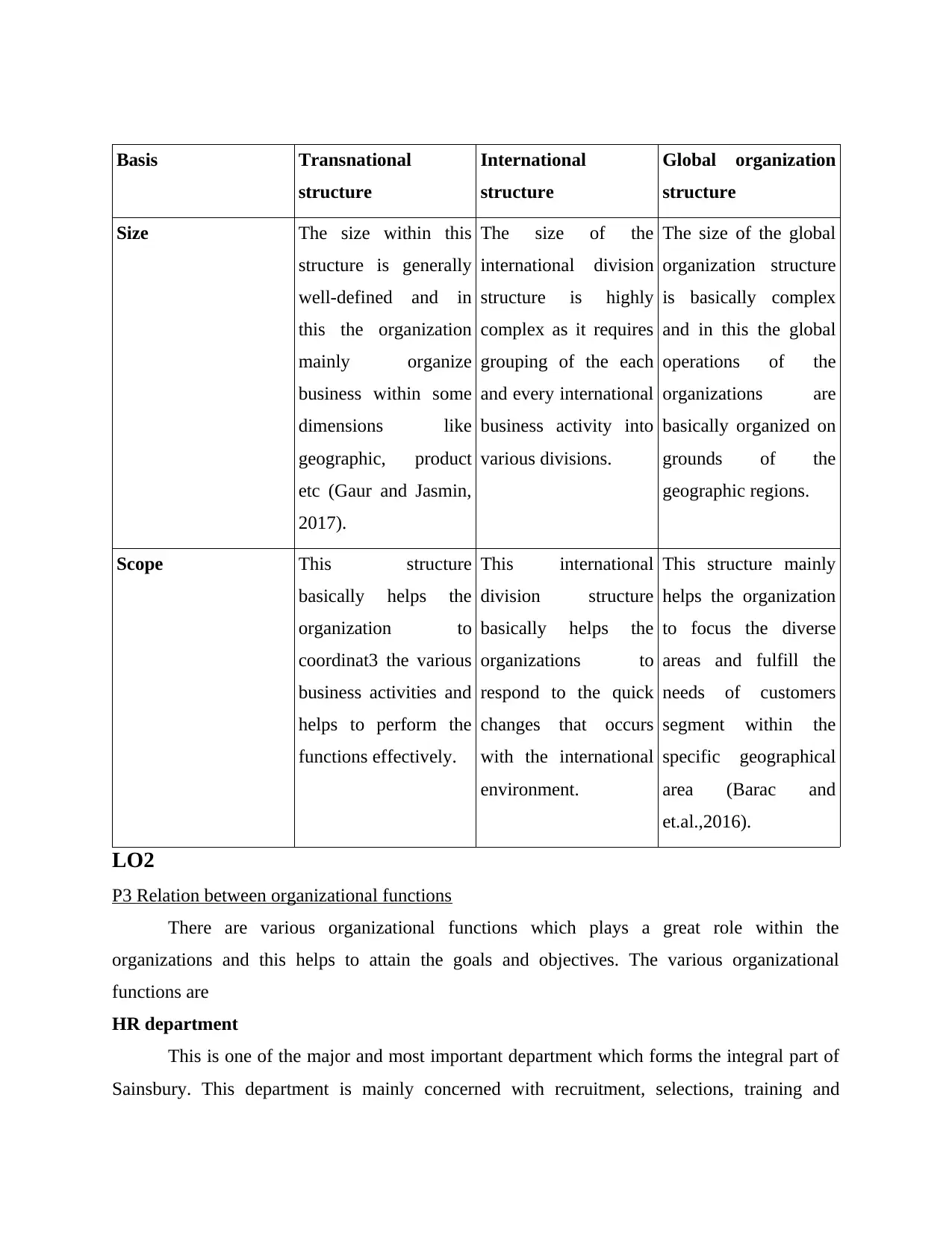
Basis Transnational
structure
International
structure
Global organization
structure
Size The size within this
structure is generally
well-defined and in
this the organization
mainly organize
business within some
dimensions like
geographic, product
etc (Gaur and Jasmin,
2017).
The size of the
international division
structure is highly
complex as it requires
grouping of the each
and every international
business activity into
various divisions.
The size of the global
organization structure
is basically complex
and in this the global
operations of the
organizations are
basically organized on
grounds of the
geographic regions.
Scope This structure
basically helps the
organization to
coordinat3 the various
business activities and
helps to perform the
functions effectively.
This international
division structure
basically helps the
organizations to
respond to the quick
changes that occurs
with the international
environment.
This structure mainly
helps the organization
to focus the diverse
areas and fulfill the
needs of customers
segment within the
specific geographical
area (Barac and
et.al.,2016).
LO2
P3 Relation between organizational functions
There are various organizational functions which plays a great role within the
organizations and this helps to attain the goals and objectives. The various organizational
functions are
HR department
This is one of the major and most important department which forms the integral part of
Sainsbury. This department is mainly concerned with recruitment, selections, training and
structure
International
structure
Global organization
structure
Size The size within this
structure is generally
well-defined and in
this the organization
mainly organize
business within some
dimensions like
geographic, product
etc (Gaur and Jasmin,
2017).
The size of the
international division
structure is highly
complex as it requires
grouping of the each
and every international
business activity into
various divisions.
The size of the global
organization structure
is basically complex
and in this the global
operations of the
organizations are
basically organized on
grounds of the
geographic regions.
Scope This structure
basically helps the
organization to
coordinat3 the various
business activities and
helps to perform the
functions effectively.
This international
division structure
basically helps the
organizations to
respond to the quick
changes that occurs
with the international
environment.
This structure mainly
helps the organization
to focus the diverse
areas and fulfill the
needs of customers
segment within the
specific geographical
area (Barac and
et.al.,2016).
LO2
P3 Relation between organizational functions
There are various organizational functions which plays a great role within the
organizations and this helps to attain the goals and objectives. The various organizational
functions are
HR department
This is one of the major and most important department which forms the integral part of
Sainsbury. This department is mainly concerned with recruitment, selections, training and
Paraphrase This Document
Need a fresh take? Get an instant paraphrase of this document with our AI Paraphraser
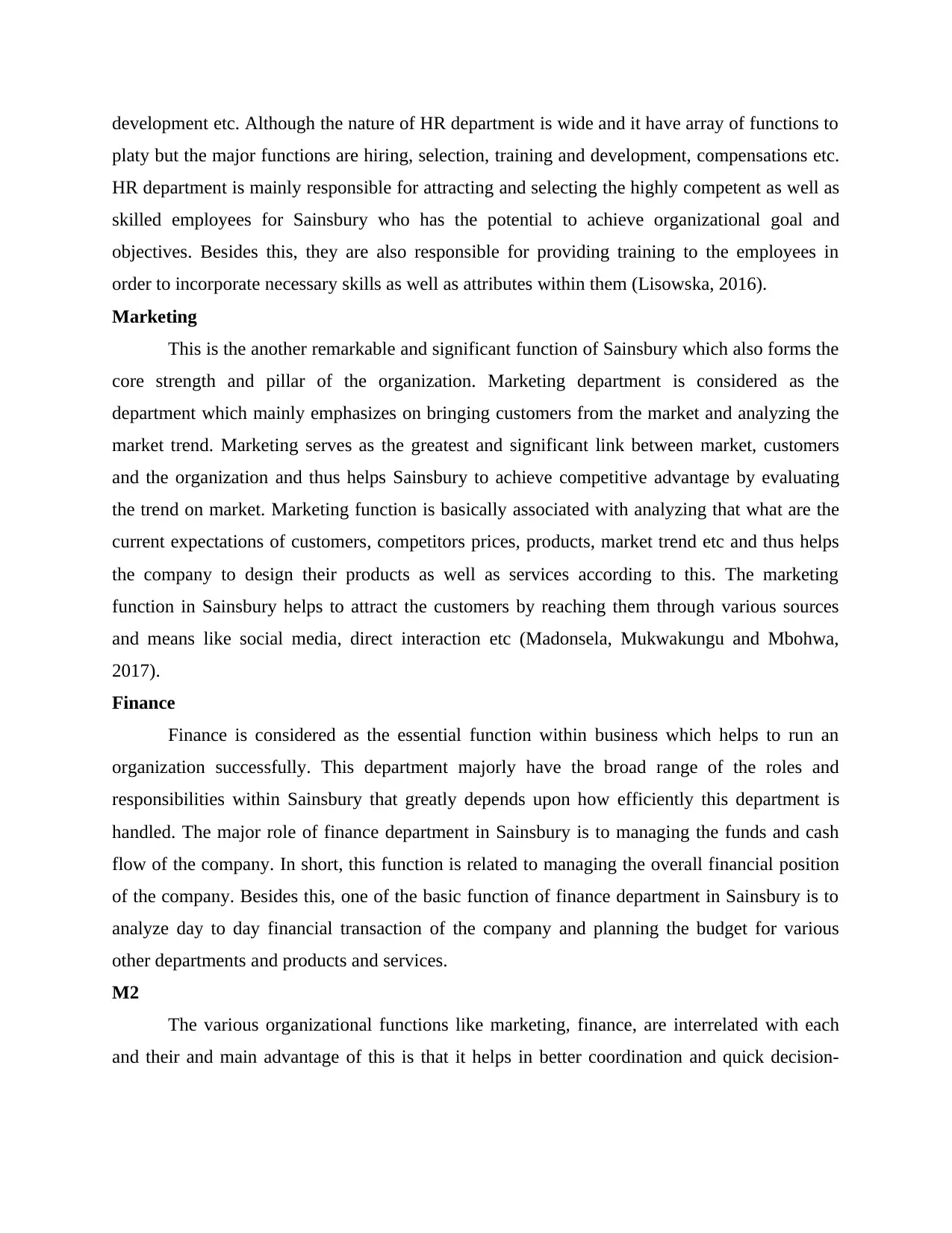
development etc. Although the nature of HR department is wide and it have array of functions to
platy but the major functions are hiring, selection, training and development, compensations etc.
HR department is mainly responsible for attracting and selecting the highly competent as well as
skilled employees for Sainsbury who has the potential to achieve organizational goal and
objectives. Besides this, they are also responsible for providing training to the employees in
order to incorporate necessary skills as well as attributes within them (Lisowska, 2016).
Marketing
This is the another remarkable and significant function of Sainsbury which also forms the
core strength and pillar of the organization. Marketing department is considered as the
department which mainly emphasizes on bringing customers from the market and analyzing the
market trend. Marketing serves as the greatest and significant link between market, customers
and the organization and thus helps Sainsbury to achieve competitive advantage by evaluating
the trend on market. Marketing function is basically associated with analyzing that what are the
current expectations of customers, competitors prices, products, market trend etc and thus helps
the company to design their products as well as services according to this. The marketing
function in Sainsbury helps to attract the customers by reaching them through various sources
and means like social media, direct interaction etc (Madonsela, Mukwakungu and Mbohwa,
2017).
Finance
Finance is considered as the essential function within business which helps to run an
organization successfully. This department majorly have the broad range of the roles and
responsibilities within Sainsbury that greatly depends upon how efficiently this department is
handled. The major role of finance department in Sainsbury is to managing the funds and cash
flow of the company. In short, this function is related to managing the overall financial position
of the company. Besides this, one of the basic function of finance department in Sainsbury is to
analyze day to day financial transaction of the company and planning the budget for various
other departments and products and services.
M2
The various organizational functions like marketing, finance, are interrelated with each
and their and main advantage of this is that it helps in better coordination and quick decision-
platy but the major functions are hiring, selection, training and development, compensations etc.
HR department is mainly responsible for attracting and selecting the highly competent as well as
skilled employees for Sainsbury who has the potential to achieve organizational goal and
objectives. Besides this, they are also responsible for providing training to the employees in
order to incorporate necessary skills as well as attributes within them (Lisowska, 2016).
Marketing
This is the another remarkable and significant function of Sainsbury which also forms the
core strength and pillar of the organization. Marketing department is considered as the
department which mainly emphasizes on bringing customers from the market and analyzing the
market trend. Marketing serves as the greatest and significant link between market, customers
and the organization and thus helps Sainsbury to achieve competitive advantage by evaluating
the trend on market. Marketing function is basically associated with analyzing that what are the
current expectations of customers, competitors prices, products, market trend etc and thus helps
the company to design their products as well as services according to this. The marketing
function in Sainsbury helps to attract the customers by reaching them through various sources
and means like social media, direct interaction etc (Madonsela, Mukwakungu and Mbohwa,
2017).
Finance
Finance is considered as the essential function within business which helps to run an
organization successfully. This department majorly have the broad range of the roles and
responsibilities within Sainsbury that greatly depends upon how efficiently this department is
handled. The major role of finance department in Sainsbury is to managing the funds and cash
flow of the company. In short, this function is related to managing the overall financial position
of the company. Besides this, one of the basic function of finance department in Sainsbury is to
analyze day to day financial transaction of the company and planning the budget for various
other departments and products and services.
M2
The various organizational functions like marketing, finance, are interrelated with each
and their and main advantage of this is that it helps in better coordination and quick decision-
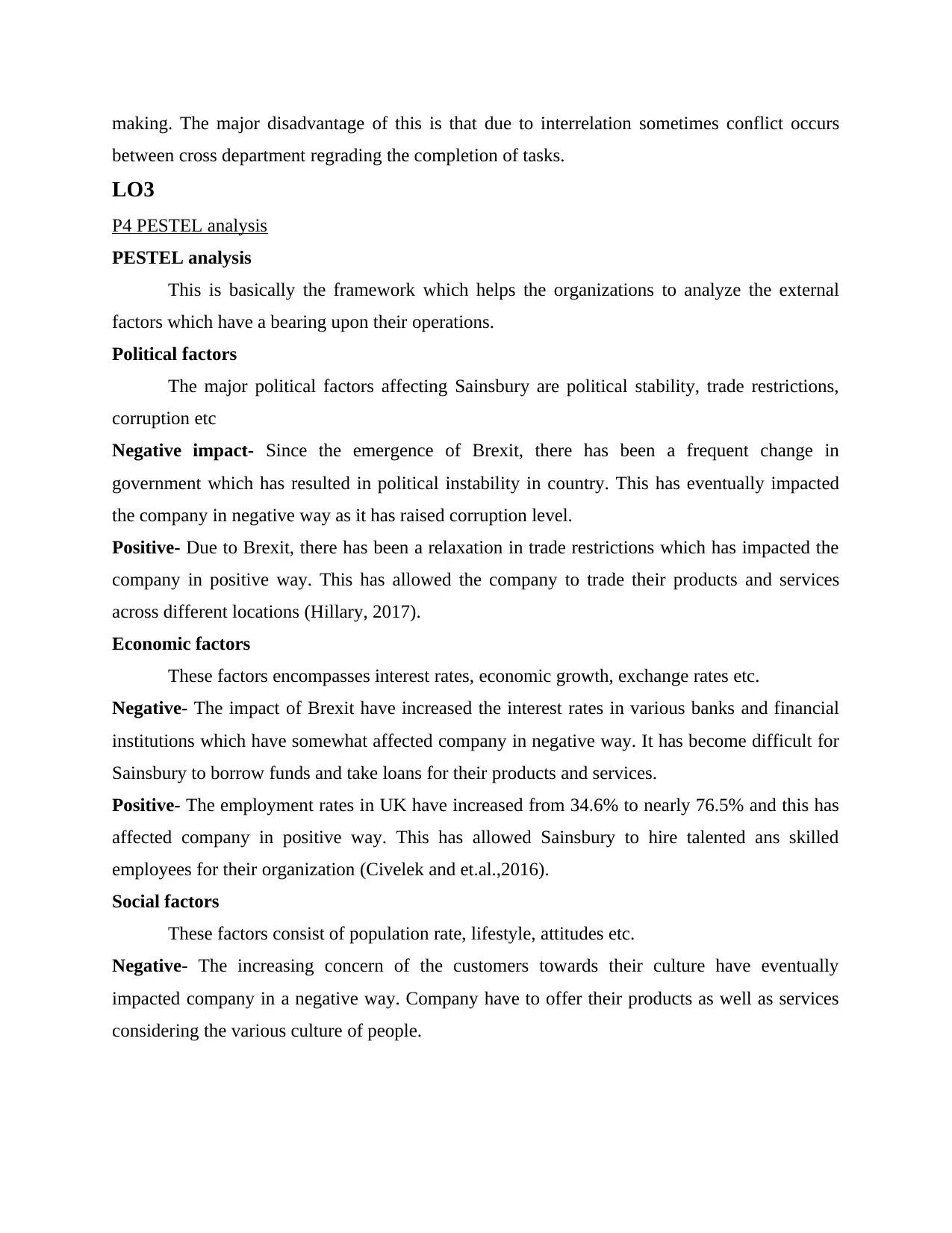
making. The major disadvantage of this is that due to interrelation sometimes conflict occurs
between cross department regrading the completion of tasks.
LO3
P4 PESTEL analysis
PESTEL analysis
This is basically the framework which helps the organizations to analyze the external
factors which have a bearing upon their operations.
Political factors
The major political factors affecting Sainsbury are political stability, trade restrictions,
corruption etc
Negative impact- Since the emergence of Brexit, there has been a frequent change in
government which has resulted in political instability in country. This has eventually impacted
the company in negative way as it has raised corruption level.
Positive- Due to Brexit, there has been a relaxation in trade restrictions which has impacted the
company in positive way. This has allowed the company to trade their products and services
across different locations (Hillary, 2017).
Economic factors
These factors encompasses interest rates, economic growth, exchange rates etc.
Negative- The impact of Brexit have increased the interest rates in various banks and financial
institutions which have somewhat affected company in negative way. It has become difficult for
Sainsbury to borrow funds and take loans for their products and services.
Positive- The employment rates in UK have increased from 34.6% to nearly 76.5% and this has
affected company in positive way. This has allowed Sainsbury to hire talented ans skilled
employees for their organization (Civelek and et.al.,2016).
Social factors
These factors consist of population rate, lifestyle, attitudes etc.
Negative- The increasing concern of the customers towards their culture have eventually
impacted company in a negative way. Company have to offer their products as well as services
considering the various culture of people.
between cross department regrading the completion of tasks.
LO3
P4 PESTEL analysis
PESTEL analysis
This is basically the framework which helps the organizations to analyze the external
factors which have a bearing upon their operations.
Political factors
The major political factors affecting Sainsbury are political stability, trade restrictions,
corruption etc
Negative impact- Since the emergence of Brexit, there has been a frequent change in
government which has resulted in political instability in country. This has eventually impacted
the company in negative way as it has raised corruption level.
Positive- Due to Brexit, there has been a relaxation in trade restrictions which has impacted the
company in positive way. This has allowed the company to trade their products and services
across different locations (Hillary, 2017).
Economic factors
These factors encompasses interest rates, economic growth, exchange rates etc.
Negative- The impact of Brexit have increased the interest rates in various banks and financial
institutions which have somewhat affected company in negative way. It has become difficult for
Sainsbury to borrow funds and take loans for their products and services.
Positive- The employment rates in UK have increased from 34.6% to nearly 76.5% and this has
affected company in positive way. This has allowed Sainsbury to hire talented ans skilled
employees for their organization (Civelek and et.al.,2016).
Social factors
These factors consist of population rate, lifestyle, attitudes etc.
Negative- The increasing concern of the customers towards their culture have eventually
impacted company in a negative way. Company have to offer their products as well as services
considering the various culture of people.
⊘ This is a preview!⊘
Do you want full access?
Subscribe today to unlock all pages.

Trusted by 1+ million students worldwide
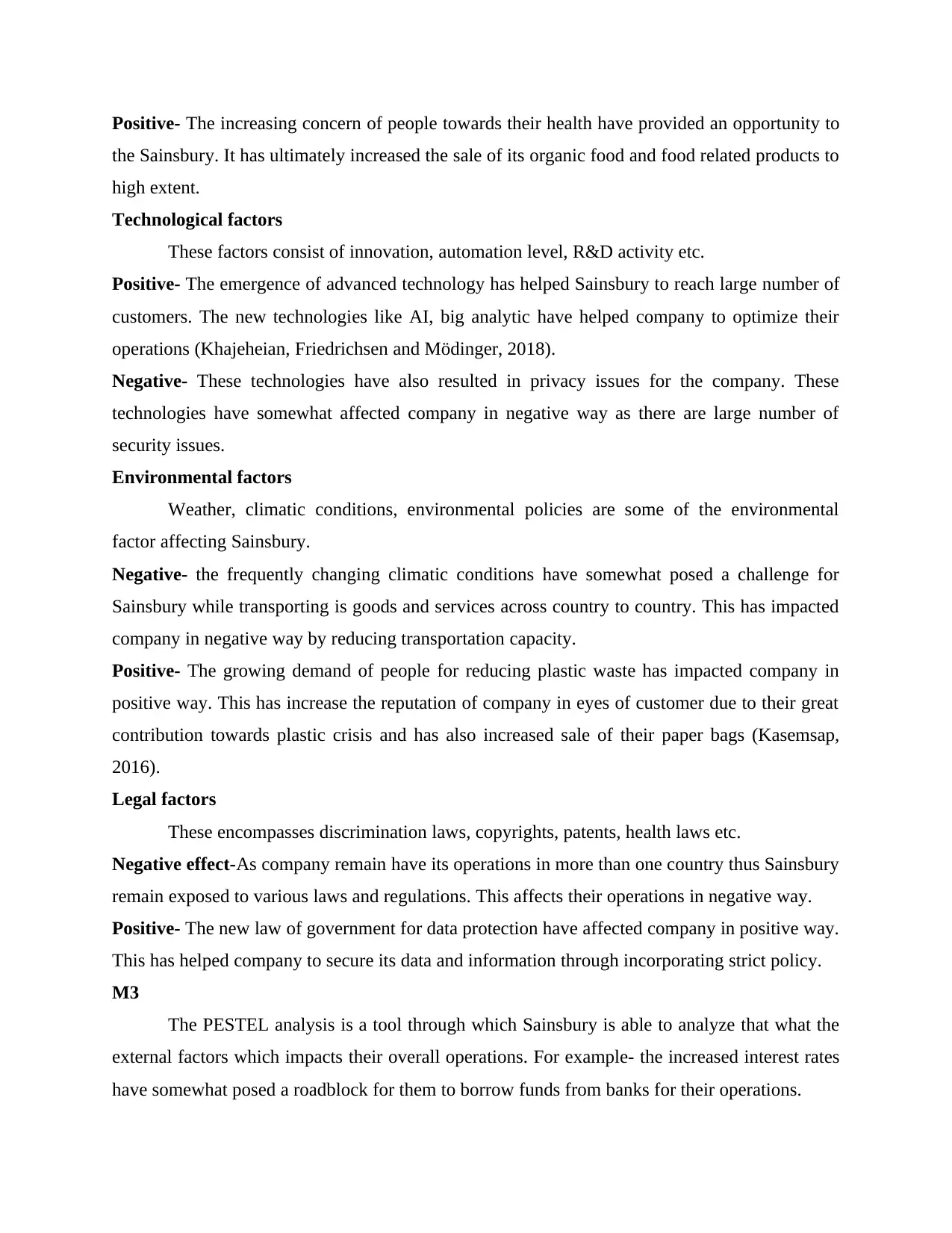
Positive- The increasing concern of people towards their health have provided an opportunity to
the Sainsbury. It has ultimately increased the sale of its organic food and food related products to
high extent.
Technological factors
These factors consist of innovation, automation level, R&D activity etc.
Positive- The emergence of advanced technology has helped Sainsbury to reach large number of
customers. The new technologies like AI, big analytic have helped company to optimize their
operations (Khajeheian, Friedrichsen and Mödinger, 2018).
Negative- These technologies have also resulted in privacy issues for the company. These
technologies have somewhat affected company in negative way as there are large number of
security issues.
Environmental factors
Weather, climatic conditions, environmental policies are some of the environmental
factor affecting Sainsbury.
Negative- the frequently changing climatic conditions have somewhat posed a challenge for
Sainsbury while transporting is goods and services across country to country. This has impacted
company in negative way by reducing transportation capacity.
Positive- The growing demand of people for reducing plastic waste has impacted company in
positive way. This has increase the reputation of company in eyes of customer due to their great
contribution towards plastic crisis and has also increased sale of their paper bags (Kasemsap,
2016).
Legal factors
These encompasses discrimination laws, copyrights, patents, health laws etc.
Negative effect-As company remain have its operations in more than one country thus Sainsbury
remain exposed to various laws and regulations. This affects their operations in negative way.
Positive- The new law of government for data protection have affected company in positive way.
This has helped company to secure its data and information through incorporating strict policy.
M3
The PESTEL analysis is a tool through which Sainsbury is able to analyze that what the
external factors which impacts their overall operations. For example- the increased interest rates
have somewhat posed a roadblock for them to borrow funds from banks for their operations.
the Sainsbury. It has ultimately increased the sale of its organic food and food related products to
high extent.
Technological factors
These factors consist of innovation, automation level, R&D activity etc.
Positive- The emergence of advanced technology has helped Sainsbury to reach large number of
customers. The new technologies like AI, big analytic have helped company to optimize their
operations (Khajeheian, Friedrichsen and Mödinger, 2018).
Negative- These technologies have also resulted in privacy issues for the company. These
technologies have somewhat affected company in negative way as there are large number of
security issues.
Environmental factors
Weather, climatic conditions, environmental policies are some of the environmental
factor affecting Sainsbury.
Negative- the frequently changing climatic conditions have somewhat posed a challenge for
Sainsbury while transporting is goods and services across country to country. This has impacted
company in negative way by reducing transportation capacity.
Positive- The growing demand of people for reducing plastic waste has impacted company in
positive way. This has increase the reputation of company in eyes of customer due to their great
contribution towards plastic crisis and has also increased sale of their paper bags (Kasemsap,
2016).
Legal factors
These encompasses discrimination laws, copyrights, patents, health laws etc.
Negative effect-As company remain have its operations in more than one country thus Sainsbury
remain exposed to various laws and regulations. This affects their operations in negative way.
Positive- The new law of government for data protection have affected company in positive way.
This has helped company to secure its data and information through incorporating strict policy.
M3
The PESTEL analysis is a tool through which Sainsbury is able to analyze that what the
external factors which impacts their overall operations. For example- the increased interest rates
have somewhat posed a roadblock for them to borrow funds from banks for their operations.
Paraphrase This Document
Need a fresh take? Get an instant paraphrase of this document with our AI Paraphraser
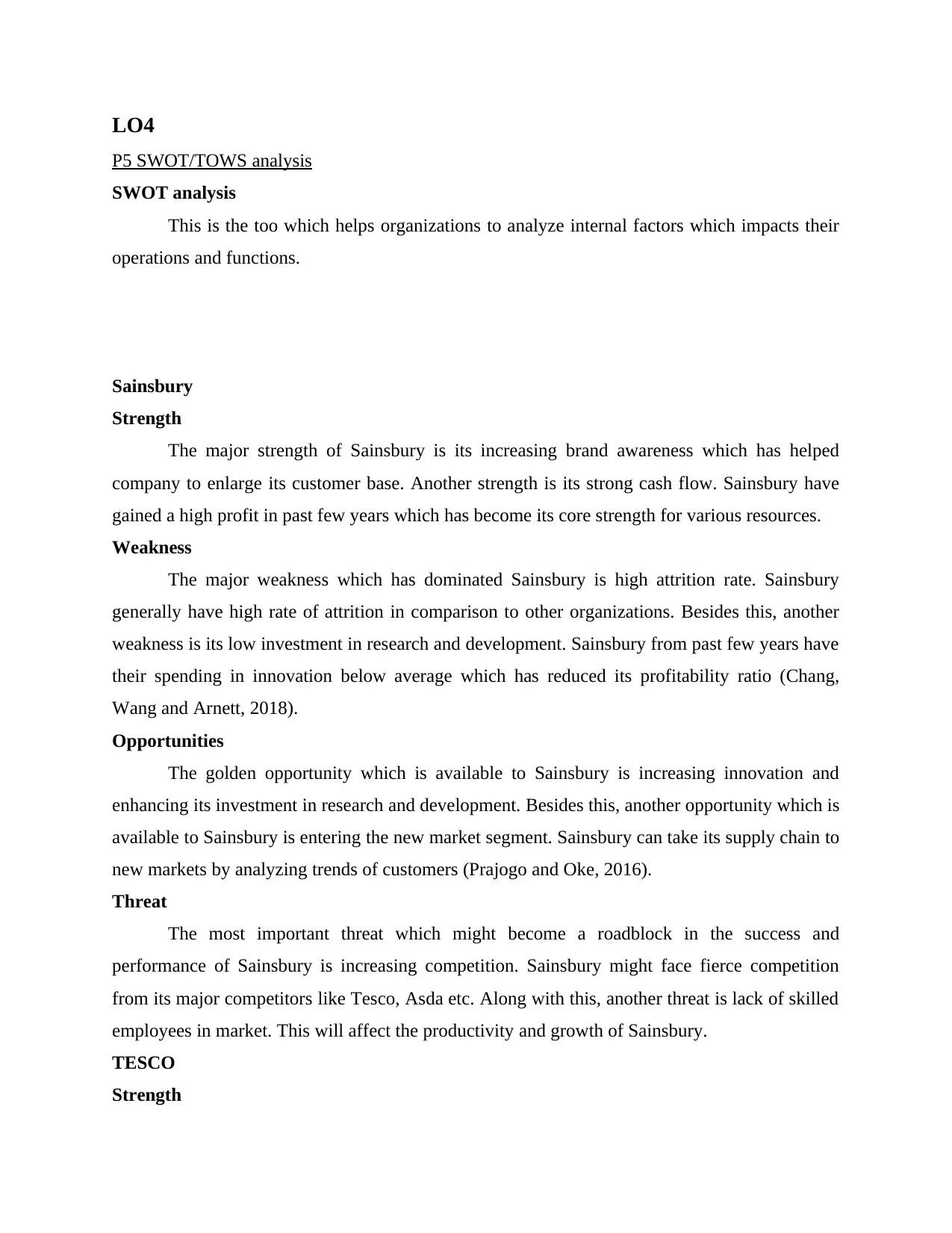
LO4
P5 SWOT/TOWS analysis
SWOT analysis
This is the too which helps organizations to analyze internal factors which impacts their
operations and functions.
Sainsbury
Strength
The major strength of Sainsbury is its increasing brand awareness which has helped
company to enlarge its customer base. Another strength is its strong cash flow. Sainsbury have
gained a high profit in past few years which has become its core strength for various resources.
Weakness
The major weakness which has dominated Sainsbury is high attrition rate. Sainsbury
generally have high rate of attrition in comparison to other organizations. Besides this, another
weakness is its low investment in research and development. Sainsbury from past few years have
their spending in innovation below average which has reduced its profitability ratio (Chang,
Wang and Arnett, 2018).
Opportunities
The golden opportunity which is available to Sainsbury is increasing innovation and
enhancing its investment in research and development. Besides this, another opportunity which is
available to Sainsbury is entering the new market segment. Sainsbury can take its supply chain to
new markets by analyzing trends of customers (Prajogo and Oke, 2016).
Threat
The most important threat which might become a roadblock in the success and
performance of Sainsbury is increasing competition. Sainsbury might face fierce competition
from its major competitors like Tesco, Asda etc. Along with this, another threat is lack of skilled
employees in market. This will affect the productivity and growth of Sainsbury.
TESCO
Strength
P5 SWOT/TOWS analysis
SWOT analysis
This is the too which helps organizations to analyze internal factors which impacts their
operations and functions.
Sainsbury
Strength
The major strength of Sainsbury is its increasing brand awareness which has helped
company to enlarge its customer base. Another strength is its strong cash flow. Sainsbury have
gained a high profit in past few years which has become its core strength for various resources.
Weakness
The major weakness which has dominated Sainsbury is high attrition rate. Sainsbury
generally have high rate of attrition in comparison to other organizations. Besides this, another
weakness is its low investment in research and development. Sainsbury from past few years have
their spending in innovation below average which has reduced its profitability ratio (Chang,
Wang and Arnett, 2018).
Opportunities
The golden opportunity which is available to Sainsbury is increasing innovation and
enhancing its investment in research and development. Besides this, another opportunity which is
available to Sainsbury is entering the new market segment. Sainsbury can take its supply chain to
new markets by analyzing trends of customers (Prajogo and Oke, 2016).
Threat
The most important threat which might become a roadblock in the success and
performance of Sainsbury is increasing competition. Sainsbury might face fierce competition
from its major competitors like Tesco, Asda etc. Along with this, another threat is lack of skilled
employees in market. This will affect the productivity and growth of Sainsbury.
TESCO
Strength
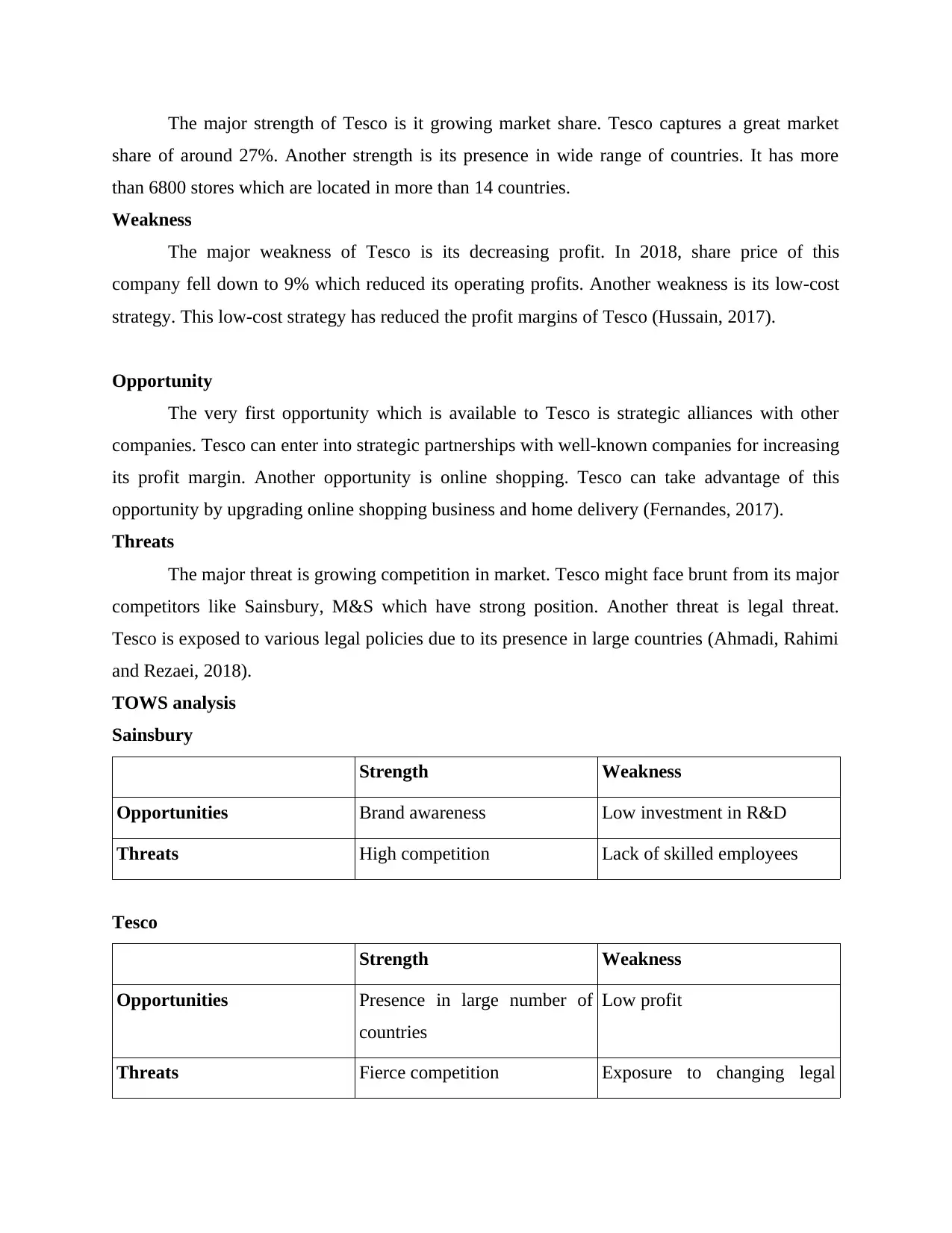
The major strength of Tesco is it growing market share. Tesco captures a great market
share of around 27%. Another strength is its presence in wide range of countries. It has more
than 6800 stores which are located in more than 14 countries.
Weakness
The major weakness of Tesco is its decreasing profit. In 2018, share price of this
company fell down to 9% which reduced its operating profits. Another weakness is its low-cost
strategy. This low-cost strategy has reduced the profit margins of Tesco (Hussain, 2017).
Opportunity
The very first opportunity which is available to Tesco is strategic alliances with other
companies. Tesco can enter into strategic partnerships with well-known companies for increasing
its profit margin. Another opportunity is online shopping. Tesco can take advantage of this
opportunity by upgrading online shopping business and home delivery (Fernandes, 2017).
Threats
The major threat is growing competition in market. Tesco might face brunt from its major
competitors like Sainsbury, M&S which have strong position. Another threat is legal threat.
Tesco is exposed to various legal policies due to its presence in large countries (Ahmadi, Rahimi
and Rezaei, 2018).
TOWS analysis
Sainsbury
Strength Weakness
Opportunities Brand awareness Low investment in R&D
Threats High competition Lack of skilled employees
Tesco
Strength Weakness
Opportunities Presence in large number of
countries
Low profit
Threats Fierce competition Exposure to changing legal
share of around 27%. Another strength is its presence in wide range of countries. It has more
than 6800 stores which are located in more than 14 countries.
Weakness
The major weakness of Tesco is its decreasing profit. In 2018, share price of this
company fell down to 9% which reduced its operating profits. Another weakness is its low-cost
strategy. This low-cost strategy has reduced the profit margins of Tesco (Hussain, 2017).
Opportunity
The very first opportunity which is available to Tesco is strategic alliances with other
companies. Tesco can enter into strategic partnerships with well-known companies for increasing
its profit margin. Another opportunity is online shopping. Tesco can take advantage of this
opportunity by upgrading online shopping business and home delivery (Fernandes, 2017).
Threats
The major threat is growing competition in market. Tesco might face brunt from its major
competitors like Sainsbury, M&S which have strong position. Another threat is legal threat.
Tesco is exposed to various legal policies due to its presence in large countries (Ahmadi, Rahimi
and Rezaei, 2018).
TOWS analysis
Sainsbury
Strength Weakness
Opportunities Brand awareness Low investment in R&D
Threats High competition Lack of skilled employees
Tesco
Strength Weakness
Opportunities Presence in large number of
countries
Low profit
Threats Fierce competition Exposure to changing legal
⊘ This is a preview!⊘
Do you want full access?
Subscribe today to unlock all pages.

Trusted by 1+ million students worldwide
1 out of 15
Related Documents
Your All-in-One AI-Powered Toolkit for Academic Success.
+13062052269
info@desklib.com
Available 24*7 on WhatsApp / Email
![[object Object]](/_next/static/media/star-bottom.7253800d.svg)
Unlock your academic potential
Copyright © 2020–2025 A2Z Services. All Rights Reserved. Developed and managed by ZUCOL.




